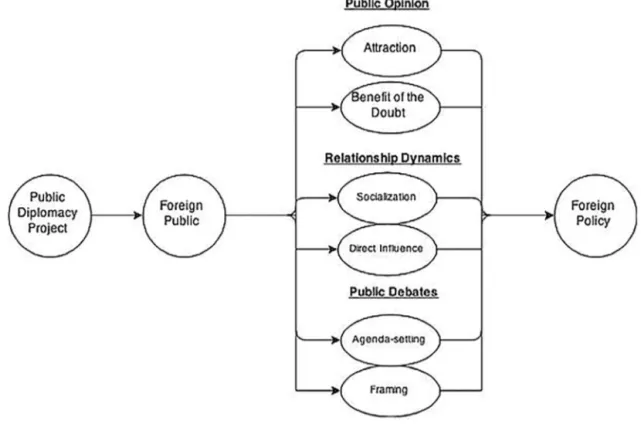ContentslistsavailableatScienceDirect
Public
Relations
Review
Pathways
of
connection:
An
analytical
approach
to
the
impacts
of
public
diplomacy
Efe
Sevin
DepartmentofPublicRelationsandInformation,KadirHasUniversity,CibaliKampüsüKadirHasCaddesiFatih, ˙Istanbul,Turkey
a
r
t
i
c
l
e
i
n
f
o
Articlehistory:
Received12January2015
Receivedinrevisedform22June2015
Accepted3July2015 Keywords: Publicdiplomacy Evaluation Measurement Pathwaysofconnection Softpower Publicrelations
a
b
s
t
r
a
c
t
Publicdiplomacy,albeititsfunctionalsimilaritieswithpublicrelationsandother corpo-ratecommunicationtools,isinherentlyaforeignpolicytool,usedbypractitionerstates toadvancetheirnationalinterestsandachievetheirforeignpolicygoals.Thepurposeof thistheoreticalarticleistoprovideaframeworktoanalyzetheimpactsofpublic diplo-macyprojectsbyacknowledgingbothitscommunicationaspectandpoliticalnature.The pathwaysofconnectionframeworkisbuiltintwo-steps.First,thepublicdiplomacyconcept issituatedininternationalpoliticsbyevaluatingtheconceptthroughmainstream inter-nationalrelationstheories.Thisevaluationyieldsthreeareasonwhichpublicdiplomacy projectsmighthaveanimpact.Second,theexistingacademicandpracticalmeasurement modelsarecategorizedundertheseareasandtwopathwaysperareaarepresented.The theoreticalframeworkcanbeusedtounderstanddifferentoutcomesofpublicdiplomacy projectsandtoprovideamoreaccuratemeasurementoftheirsuccess.
©2015ElsevierInc.Allrightsreserved.
1. Introduction
Howcanweseetheunseenandobservetheunobservable?Thisquestionsummarizesthechallengesfacedbythescholars andpractitionersintheirattemptstoassessandevaluatetheoutcomesofpublicdiplomacyprojects.Measurementisknown tobeatroublesometaskinpublicdiplomacy.Projectstendtoyieldchangesonintangibleconcepts–suchasawarenessand attitudes–andthesechangesoccuroveralong-timeperiodandcannotbedirectlyattributedtothem(foramoreinclusive listofchallengesinevaluation,cf.Banks,2011).Eventhoughaprojectmightbeabletocontributetoamorepositivepublic opiniontowardsapractitionerstate,thischangemighttakeplaceoveryears–orevendecades–andinconjunctionwith othervariablessuchaschangesinworldpoliticsorotherdiplomatictransformations.Asthesechangesaredifficultto capture,itisnotsurprisingtoobservethelackofrobustmeasurementmechanismsbutratherthepresenceofattempts measuringtheoutputsofprojects(Pamment,2013).
Publicdiplomacy,despitealackofagreementonitsdefinition,isusuallyseenasafundamentalcommunicationand publicrelationsactivitycarriedoutbystates(Fitzpatrick,Fullerton,&Kendrick,2013).Thefunctionalsimilaritiesamong theseconceptsencouragetheuseofpublicrelationstheoriesandmodelstoexaminetheimpactsofpublicdiplomacy projects.Yet,asitwillbearguedthroughoutthispaper,suchamono-disciplinaryapproachhastheinherentdangerof becomingtheproverbial“Maslow’shammer.”1
E-mailaddress:efe.sevin@khas.edu.tr
1 AbrahamMaslowiscreditedwiththesaying“Tothemanwhoonlyhasahammer,everythingheencountersbeginstolooklikeanail.”
http://dx.doi.org/10.1016/j.pubrev.2015.07.003
andinternationalenvironmentbyconnectingitscommunicationaspectwithplausibleimpactsonforeignpolicy.Public diplomacyworksasatooltohelpachieveforeignpolicygoalsofthepractitionercountries(Djerejian,2003)andoperates withintheinternationalpoliticalenvironment.Practitionercountriesuseavarietyofpublicdiplomacyprojects–suchas internationalbroadcastingandstudentexchanges–withthepenultimateobjectiveofreachingouttoforeignpublicsand ultimateobjectiveofadvancingtheirowninterests.
Thetheoreticalargumentsarepresentedintwosteps.First,publicdiplomacyisconceptualizedasaforeignpolicytooland itsexpectedimpactsareevaluatedthroughthelensofmainstreaminternationalrelationstheories.Inthisstep,itisargued thatagivenpublicdiplomacyprojectmightmanifestitsimpactinthreedifferentareas.Second,theexistingmeasurement practicesandacademicmodelsarecategorizedundertheseareastocreatesixpathwaysofconnectionbetweenprojects andforeignpolicyobjectives.
Therestofthisarticleisstructuredinfoursections.First,aworkingdefinitionofpublicdiplomacyispresentedforthis research.Second,thedefinitionisevaluatedthroughmajorinternationalrelationstheoriestoidentifyareasonwhichthe impactofpublicdiplomacycanbeobserved.Third,sixpathwaysofconnectionareintroduced.Thearticleconcludesby arguingforthecontributionsofthesixpathwaysofconnectionframework.
2. Workingdefinitionofpublicdiplomacy
Thefieldofpublicdiplomacyhasgonethrougharapidgrowth,welcomingcontributionsfromanumberofdisciplines. Itisneithernecessarynorbeneficialtodeviseauniversaldefinitionoforapproachtopublicdiplomacyaseachandevery disciplinehasitsownstrengthsandweakness.Similarly,thedefinitionusedinthisresearchisnotproposedasauniversal def-initiontoreplacetheexistingapproachesintheliterature.Theobjectiveistohighlightcommunicationandpolitics-relevant characteristicsoftheconceptbybothacknowledgingpublicdiplomacyasapublicrelationsfunctionandemphasizingits connectionwithforeignpolicy
Publicdiplomacyisfundamentallyacommunicationtoolusedbystatestoreachforeignpublics(Plavsak,2002).Public relationsscholartendtoseeitasanactivityconductedbynationsaswellasotherinternationalorganizationsand nongovern-mentalorganizationsthatentailmediarelations,promotionalandpersuasivestrategies(L’Etang,2009,p.610).International relationsscholarshighlighttheroleofpowerdynamicsandconceptualizepublicdiplomacyasaninstrumentthat govern-mentsuseto“communicatewithandattractthepublicsofothercountries,ratherthanmerelytheirgovernments”(Nye, 2008,p.95).Forthepurposesofthisresearch,adefinitionthatacknowledgestheroleofcommunication,actorsinvolved inthecommunicationactivities,statefunctions,andtheexpectedoutcomesofsuchactivitiesisrequired.Itispossibleto conceptualizepublicdiplomacyasreferringtothecommunication-basedactivitiesofstatesandstate-sanctionedactorsaimed atnon-stategroupsinothercountrieswiththeexpectationofachievingforeignpolicygoalsandobjectives.Withinthisdefinition, publicdiplomacyisanextensionoftraditionaldiplomacyintermsoftheactorsandobjectives,andisaforeignpolicytool.
3. Impactsofpublicdiplomacy
ThisstudyexpandsonYunandToth’s(2009)workthatdefinesrealistandliberalist[sic]publicdiplomacyconcepts.The authorsusetheaforementionedinternationalrelationstheoriestopresentexpectedoutcomeofpublicdiplomacyproject. Inadditiontorealismandliberalism,constructivismisalsointroducedasthethirdmajorinternationalrelationstheoryto createamoreinclusivepictureofpublicdiplomacyactivities.
AccordingtoYunandToth(2009),realistpublicdiplomacycannotseeforeignpublicsasthetargetaudiences.This counter-intuitiveargumentisinlinewiththemaintenetsofrealisttheorythatseesinternationalrelationsprimarilyasa powerplaybetweenstatesintheinternationalsystemassovereignstates,ignoringtheroleofotheractors.Publicdiplomacy projectsareexpectedtochangetheattitudesoftheforeignaudiencestoinfluencethestatebehavior.Themainassumption isthatthepublicisimportantinforeignpolicyonlyduetothecapacityofpublicopiniontochangethestatebehaviorand notasanindependentactorperse.
Thepublicdiplomacymeasurementandassessmentpracticealsosupportstheideathatinfluencingpublicopinionmight beseenasamethodtocreateimpactinforeignpolicy.Forinstance,GoldsmithandHoriuchi(2012)usepublicopinionas avariableintheirassessmentofAmericanpublicdiplomacyandforeignpolicy.Similarly,thePublicDiplomacyModelfor theAssessmentofPerformance(PD-MAP)presentedbytheAdvisoryCommissiononPublicDiplomacy(ACPD)putspublic opinionunderspotlight.PD-MAPaimsto“evaluatetargetaudience’sperception,favorability,orunderstandingpriorto andaftera[publicdiplomacy]effort”(ACPD,2010,p.26).PD-MAPpositsthatpublicdiplomacyisexpectedtoincrease theunderstandingoftheUnitedStates,favorability,andinfluenceamongforeignpublics.Thisfavorablepublicopinionis expectedtochangethebehaviorofthestates–theonlyimportantactorininternationalaffairsaccordingtorealismand realistpublicdiplomacy–andsubsequentlytohaveanimpactonforeignpolicy.
Aliberalapproachtopublicdiplomacyoperatesundertheassumptionthatstatesarenottheonlyimportantactorsin worldpolitics(Yun&Toth,2009).Liberalismtheoryarguesthatinter-staterelationscannotbeseenasindependentfrom otheractorsintheinternationalarena.Thus,foreignaffairsandpoliticsarenotonlyinfluencedbystatesbutalsobythe interactionsofnon-stateactorsthattheycalltransnationalactors(Keohane&Nye,1972).Statesarestillthedominantand
Table1
Summaryofthepathwaysofconnection.
Areas/scopeofexplanation Largerimpact Focusedimpact
Publicopinion Attraction Benefitofthedoubt
Relationshipdynamics Socialization Directinfluence
Publicdebates Agenda-setting Framing
powerful–probablythemostpowerful–actorsintheinternationalarenahowevertheyarenolongerthesoleactors.Public diplomacyisthusaplatformtointeractwiththenewnon-stateactors.
TheNorthAtlanticTreaty Organization(NATO)’sframework forplanningand evaluatingpublicdiplomacyprojects includesspecificguidelinesforpeople-to-peopleengagement.Itisarguedthatpeople-to-peopleengagementisakeyaspect ofNATO’soutreachenablingtheAlliancetobuildrelationshipswithindividuals,influencers,andthetargetaudiencesof whichtheyareapart(JointAnalysisandLessonsLearnedCentre,2013,p.48).Themeasurementpracticeisdesignedtolook atthenumberofpeoplereachedandofindividualswhokeepincontactwithNATOafterapublicdiplomacyproject(Joint AnalysisandLessonsLearnedCentre,2013,p.B-3).Thisrelationship-basedapproachalsoincreasedtheinteresttosocial networkanalysisasamethodtomeasuretheimpactsofprojects.Forinstance,FisherandMontez(2011)analyzedtheonline networksduringPresidentBarackObama’svisittoBrazilinMarch2011.TheDepartmentofStateandtheAmericanEmbassy inthecountryusedawebsite,andseveralsocialmediaplatforms–suchasTwitter,Orkut,andFacebook–topromotethe eventandengagewiththelocalpopulation,thusaddingapublicdiplomacycomponenttothepresident’strip(Fisher& Montez,2011,pp.8–10).Thesocialnetworkanalysisportrayedhowpublicdiplomacywasabletoengagenon-stateactors duringthepresidentialvisit,arguingthatthedigitalpublicdiplomacyengagementmadeitpossibleforthepresidentialvisit toreachnon-stateactors.Thus,publicdiplomacyprojectsmightbedesignedtoincreaserelationswithnon-stateactors. Liberalismarguesfortheimportanceofamultitudeofactorsinadditiontostatesininternationalaffairs.Publicdiplomacy establishescommunicationbridgeswiththesenon-stateactors.
Thethirdtheory,constructivism,arguesthatinternationalrelationsoperateonstructuresandidentitiesthataresocially created.Materialaspectsofforeignaffairsarenotasimportantasthesocialmeaningtheycarry.Therefore,beingableto influencethesesocialmeaningscanbeseenasasourceofpower(VanHam,2010).Aconstructivistpublicdiplomacy,thus, isbasedonanassumptionthatnorms,values,andidentitiesininternationalrelationsarenotdefinedbymaterialpower sources–suchasmilitarypoweroreconomicinfrastructure–butaresocialconstructs(VanHam,2002).Publicdiplomacy canmanipulatetheseconstructsbyencouragingandinfluencingdiscussionsandisthusatooltoshapethepublicdebatein foreigncountries(Gilboa,2008).
Publicdiplomacyhasthecapacitytochangethediscourse inagiven country.AsthestudyofZhangandCameron (2003)demonstrates,Chinesepublicdiplomacycarriesthisobjectiveinitsattempttoimprovetheimageofthecountryby influencingmediacoverage.ChinacarriedoutacampaignthatincludedatouringculturalexhibitionintheUnitedStatesand aseriesofmediaappearances.ZhangandCameron(2003)arguethattheseprojectsweresuccessfulinreducingthenegative coverageaboutChinaintheUnitedStatesbyencouragingthecoverageofdifferentaspectsofChina.Similarly,Britishpublic diplomacypromoteswomen’sandgirls’empowermentconceptsthroughleadershipprogramsandconferencesinregions withgenderinequalityissues(BritishCouncil,2014).Norwegianpublicdiplomacyintroducestheconceptofcorporate socialresponsibilitytoforeignpublics(MinistryofForeignAffairs,Norway,2009).Priortopublicdiplomacyprojects,these issueswerenotnecessarilypublicallydebatedamongtargetaudiences.Inotherwords,conceptssuchasgenderequality ordemocracywerenotrelevantsocialconstructsinforeignpolicyconductsoftargetcountries.Publicdiplomacyprojects influencethetopicsinpublicdebates.
Publicdiplomacyindeedisatoolintheforeignpolicytoolkitthatmakesitpossibletoreachamultitudeofinfluentialactors (Kelley,2010a)toadvancenationinterestsandtocontributetotheachievementofpolicyobjectives(Malone,2001).The categoriesofrealist,liberal,andconstructivistapproachtopublicdiplomacypositionpublicdiplomacywithininternational relationsparadigmsandclarifytheareasinwhichpublicdiplomacyprojectsmightyieldimpactininternationalaffairs. Theseareasarenamelypublicopinion,relationshipdynamics,andpublicdebates.Thenextsectionusesexistingpractices andmodelstofurtheroperationalizeexpectedimpactsofpublicdiplomacy.
4. Establishingthepathwaysofconnection
Forthisresearch,publicdiplomacyisdefinedasthecommunication-basedactivitiesofstatesandstate-sanctionedactors aimedatnon-stategroupsinothercountrieswiththeexpectationofhelpingachieveforeignpolicygoalsandobjectives. Basedontheconjunctionofthisdefinitionwithinternationalrelationstheories,threeareastoobservetheimpactofpublic diplomacyarepresented:publicopinion,relationshipdynamics,andpublicdebates.Yet,theseareasfallshortinconnecting thepenultimateobjectiveofpublicdiplomacy–reachingthepublic–withtheultimateobjective–reachingforeignpolicy goalsandadvancingnationalinterestsofthepractitionercountries.Inthissection,twosuchpathwaysofconnectionare proposedwithineacharea,onewithalargerimpactinthesaidareaandonewithamorefocusedimpact.Thesixpathways ofconnectionareidentifiedthroughastudyoftheliteratureandthepractice.Table1presentsasummaryofthepathways withinallthreeareas.
changepolicyoutcomesthroughattractionandco-optionasopposedtothroughcoercivehardpowercapabilitiesbyusing theirculture,domesticvaluesandpolicies,andforeignpolicy(Nye,2004).Acountry’sculturecancreateattractionthrough whichforeignpolicyobjectivescanbeachieved.Forinstance,CraigHayden(2012)discusseshowTaroAso,theformer PrimeMinisterofJapan,utilizedJapanesepopularcultureitems–suchasmanga,anime,andJ-pop–toincreaseJapanese presenceintheinternationalarena.Additionally,acountry’sdomesticpoliticalvaluesanditsabilitytoupholdsuchvalues cancreateattraction.China’sproblemswithattractioninandforeignpolicytowardstheWesternworldisusuallyattributed toitsdomesticvaluesandpolicies,suchashumanrightsviolationsandthesingle-partysystem(Wang,2008,p.261).Last, acountry’sforeignpolicydecisionsareinfluentialincreatingattraction.Vickers(2004)introducestheexampleofCanada. Thecountry’smulti-stakeholderunderstandinginitsforeignpolicyisarguedtobeinstrumentalingatheringsupportwhen CanadaaskedforamoreinclusiveUnitedNationsSecurityCouncilinlate1990s(Vickers,2004).Subsequently,theCouncil invitedmembersofacademiaandvariousnongovernmentalorganizations(NGOs)toitsmeetingsforconsultation.Inshort, theattractionpathwayseespublicdiplomacyisseenasatooltobroadcastsoftpowerresourcestotargetaudiencesenmasse (Nye,2011).Publicdiplomacyincreasesacountry’sattractionandcreatesageneralfavorablepublicopiniontowardsitby increasingtheexposureofforeignpublicstoitssoftpowerassets.Foreignpolicyinfluence“happensvia...viewsamongthe masspublic”(Goldsmith&Horiuchi,2012,p.560).
Benefitofthedoubtisthesecondpathwayexplainingamorefocusedimpactofpublicdiplomacyonpublicopinion. Thepathwayproposesthatpublicdiplomacyprojectsandmessageschangethegeneralattitudesofthehostcountryby shapingtheperceptionoftheinterestsofthepractitionercountry.Similartotheattractionpathway,benefitofthedoubtis abouttheperceptionoftargetaudiences.Unliketheattractionpathway,theobjectiveisnottoincreasetheattractiveness ofthepractitionercountryintheeyesofthepublic.Rather,theobjectiveistointroducea‘sharedinterest’understanding betweenthepractitionerandhostcountries.Benefitofthedoubtunderstandingiscommonlyinvokedbypractitionersto emphasizetheroleofpublicdiplomacyprojects,especiallyinthebroaderframeworkofAmericanforeignaffairs.Public diplomacyprojectsareexpectedtoencourage“otherpeopletogivetheUnitedStatesthebenefitofthedoubtonspecific policyissuesorrequestforcollaboration”byestablishingapresumptionofmutualinterestsinthehostcountries(Advisory CommitteeonCulturalDiplomacy,2005,p.16).Practitionersdonotnecessarilytryto“createasympatheticinterestin[a country’s]policy...[butto]induceinfluentialpartsofthehostcountry’spublictogive...thebenefitofthedoubt”(Glade, 2009,p.241).Thus,inthelackoffullevidence–whichislikelytobethecaseinforeignaffairs–theaudiencewillhavea favorablejudgmenttowardsthepractitionercountry.WhenHassanRouhaniwaselectedaspresidentinIran,thecountrywas consideredunfriendlyanddeemednottrustworthy(Mogensen,2015).Publicdiplomacyprojectsfocusedondemonstrating thatIranhadsimilarforeignpolicyinterestswiththerestoftheworld(Mogensen,2015).PresidentRouhanipublically sharedsuchmessagesinaletterpublishedintheWashingtonPostandotherhigh-profilespeeches(Mogensen,2015).Given thefactthatthereisnocompleteinformationaboutthemotivesofIranintheinternationalarena,theseprojectsaimedto encourageforeignpublicstoconsiderthebetteralternativesorexplanations.Foreignpolicyinfluenceoccursbasedonthe audienceperceptionthatpractitionerandhostcountries,moreoftenthannot,havesimilarpolicyinterests.
Socializationpathwayarguesthattheoutputofpublicdiplomacyprojectschangethewaythepractitionercountry inter-actswithotheractorsinthehostsociety.Unlikethepublicopinionmethods,themainaimisnottomakecountrymore favorableintheeyesofthepublic.Theobjectiveistochangethenatureofrelationshipbetweenthepractitionerandhost countrybyundertakingprojects.Publicdiplomacyprojectshelppractitionercountriestoundertakenewfunctionsinthe hostsocietyandtoincrease theirlevelsofactivities.Socializationisbasedonasocialnetworkanalysisunderstanding wherethequalityandquantityofinteractionbetweenactorsareimportantandpositsthatpublicdiplomacycanbeused toincreasethevolumeandbreadthofinteractionbetweenapractitionercountryandtargetaudiences.Forinstance,the EuropeanUnion’sYouthinActionprogramissuchapublicdiplomacyproject.Theprogramfundscivilsocietyactivities bringingyoungEuropeansfromdifferentcountriestogethertoworkonproblemsthataffecttheircountries(BritishCouncil, 2011).Thelocalcivilsocietygroups,thus,interactwiththeEuropeanUnionasapotentialpartnerandfounderfortheir activities.TheUnionbecomesanimportantsupportofyouthandcivilsocietyactivities,asopposedtoasupranational orga-nizationsandaregulatorybody.Moreover,theseprojectsalsoenabletheEuropeanUnionanditsrepresentationsinother countriestoestablishrelationswiththeactorsinsociallife.Socializationpathwayarguesthatpublicdiplomacyprojects changetherelationshipdynamicsbetweenthecountriesbyincreasingthevolumeorlevelofactivitiesandbreadthortopics ofinteractions.Foreignpolicyinfluenceiscreatedthroughthesenewrelationshipsandnewfunctionsundertakenbythe practitionercountries.
Directinfluenceexplainsasmallerimpactandunderlinestheroleofelites,individualsholdingimportantpositionsin policyrelevantdecision-makingprocesses,ingeneratingoutcomes.Publicdiplomacy,asexplainedbythispathway,attempts tocommunicatewiththeseelitesdirectlyandinfluencetheirthinking(Gilboa,2008,pp.64–65).Forinstance,shortlyafter itsdeclarationofindependence,Kosovohiredconsultingcompaniestohelpcommunicatedirectlywithpublicofficialsto getinternationalrecognition(W ¨ahlisch&Xharra,2011,p.18).Directinfluencecampaignsalsotargetindividualswhohave personalaccesstopoliticalleadersandotherdecision-makers,thereforeareabletocontributetopolicyoutcomes(Graham &Kelley,2009).Inthispathway,publicdiplomacybecomesclosertolobbyingandadvocacyactivitiesinwhichpractitioners aimtoinfluencethedecisionsmadebythelegislators.Directinfluencepathwayarguesthatpublicdiplomacyisatoolto reachthepolicy-makersinahostcountry.Publicdiplomacyyieldsanimpactonforeignpolicybychangingthemindsand attitudesofelites.
Table2
Summaryofthepathwaysofconnection.
Model Publicdiplomacyworksby...
Public opin-ion
Attraction Influencingmasspublicopinion
Benefitofthedoubt Creatingtheperceptionthatpractitionerandhostcountrieshavesimilarpolicyinterests Relationshipdynamics Socialization Creatingnewrelationshipsandnewfunctionsundertakenbythepractitionercountries
Directinfluence Changingthemindsandattitudesofelites
Publicdebates Agenda-setting Introducingagivenissueorincreasingitssalienceinmediaorpublicagendasintargetaudiences Framing Changingthecoverageofanissueandhighlightingmorefavorableaspects
Thelasttwopathwaysfocusonpublicdebates.Agenda-settingpathwayreferstotwodifferentunderstandingsof‘agenda’. First,itreferstothemediaagendaandtheroleofmediainshapingthepoliticalrealityinchoosinganddisplayingnews (McCombs&Shaw,1972).Publicdiplomacyprojectscanchangethenewschosenanddisplayedinforeignmedia.The underlyingassumptionisthat“issuesreceivingthemostattentioninthemediawillbeperceivedbythepublicasthe mostimportant”(Gilboa,2008,pp.63–64).Inmediatedagenda-setting,thecountriesmightusetheirowninternational broadcastingagencies,op-eds,interviews,celebrities,andhigh-levelvisitsamongmanyothermechanismstoincreasethe salienceofagivenissueinforeignmedialandscape.Forinstance,Russiausesitsownbroadcastingnetwork,RussiaToday, topromoteagendaitemsthatareimportantfortheirforeignpolicygoals(Simons,2014).RussianPresidentVladimirPutin (2013)publishedanop-edpieceontheNewYorkTimesto“speakdirectlytotheAmericanpeople”andtoputincreasethe importancegiventotheconflictinSyriawithintheAmericanpublic.Second,independentfrommedia,anabstractconcept ofagendamightbedefinedincludingalltheimportantsubjectsdiscussedinthepublicsphereandactorsseektheprivilege tosetthisagendabyintroducingissuesthataredeemedimportantbythem(Kelley,2012).Inotherwords,agenda-setting isnotnecessarilyonlyaboutincreasingtheawarenessofagivenpopulationbutrathertoigniteaction.Forinstance,the InternationalCampaigntoBanLandmines(ICBL)startedatapointwheretheissueoflandmineswasnotevenoninternational agendaandmanagedtobringittotheattentionofinternationalsociety(Kelley,2010b).ICBLwasinstrumentalindrafting andadvocatingfortheConventionontheProhibitionoftheUse,Stockpiling,ProductionandTransferofAnti-Personnel MinesandontheirDestructionortheOttawaTreaty(Cameron,1999).Publicdiplomacymighthelpachieveforeignpolicy goalsbyintroducingagivenissueorincreasingitssalienceinmediaorpublicagendasintargetaudiences.
Framinganalyzeswhichelementsofagivenissueareincludedandexcludedindiscussions(Entman,1993)andisthe “mediaselection,exclusionof,andemphasisoncertainissuesandapproachestopromoteaparticulardefinition, interpre-tation,moralevaluation,orasolution”(Gilboa,2008,p.64).Giventhefactthatitispossibletochangethewayagivenissue iscoveredinmediachannels,publicdiplomacycanbeseenasacountry’sattemptstoexertasmuchcontrolaspossible overtheframingofpolicyissuesinforeignmediaplatforms(Entman,2008,p.89).Moreoftenthannot,itispossibleto frameanissueindifferentways.Forinstance,amilitaryinterventioncanbeframedasapeaceoperationoraninvasion. Theframinghypothesisarguesthatframesencourageaudiencestoaccept“someassumptionsoverother,andimplysome questionswhileignoringothers,”whichthereforemightmakecertainpolicyoptionsmoreplausibleintheeyesofthe public(Jamieson&Cappella,2008,p.6).GolanandCarroll’s(2012)studyofop-edsininternationalnewspapersshowthat governments,politicalfigures,aswellasotherpoliticallyactiveactorshavetriedtoframethe2011Egyptianrevolution differently.TheAmericancontributorshaveattemptedtopresentreplacingtheMubarakregimeasaplausibleoutcome whereasEgyptiancontributorshavefocusedontheneedtochangetheroleofIslamicgroupsinthesociety.Despitethe lackofanorganizedpublicdiplomacycampaignfromeitherside,EgyptiansandAmericanspresentedcontendingframes oftheissueswiththeobjectiveofharnessinginternationalsupport.Publicdiplomacy,withinthisaspect,mightconsistof “targetedmessagesdirectedatattitudinaldriversofpolicysupportoropposition”(Egner,2010,p.99),andworkthrough changingthecoverageofanissueandbyhighlightingmorefavorableaspects.
Succinctlystated,thesixpathwaysofconnectionpresentedinthispaperconstituteaframeworkthatconnectspublic diplomacyprojectswithforeignpolicyobjectives.AsshowninTable2,publicdiplomacyprojectsarecarriedoutwiththe penultimateobjectiveofcommunicatingwithforeignpublic.Theimpactsofthesecommunicationattemptscanbeobserved inthreedifferentareas.Theultimateobjectiveofcontributingtotheachievementofforeignpolicygoalscanbelinkedwith thecommunicationcomponentofpublicdiplomacythroughsixdifferentways.
5. Conclusion
Thispaperstartedoutwithanargumentthatcurrentscholarsandpractitionersarelimitedtorespectivelytheir disci-plinarymodelsandtoprojectoutputswhenassessingpublicdiplomacyprojects.Theseexistingmeasurementattemptsdo notpresentacomprehensivepicture,astheytendtodisregardthecomplexnatureofpublicdiplomacyandglobal poli-tics.Byutilizingmainstreaminternationaltheories,firstthepaperdelineatedtheareasonwhichpublicdiplomacymight demonstrateitsimpact.Subsequently,theexistingtheoriesandmodelsofassessmentwerereevaluatedtocreate‘pathways ofconnection’–statementsthatconnectpublicdiplomacywithitsultimateobjective.
Themainpremiseofthesixpathwaysofconnectionframework(cf.Fig.1)restsontwoarguments.First,itisaccepted thattherootsofpublicdiplomacyareinthepersuasionindustries(Snow,2007,p.9).Initsessence,publicdiplomacyis the“applicationofPRtostrategicrelationshipsoforganizationswithinternationalpublics”(Grunig,1993,p.143).Yet,
Figure1.Sixpathwaysofconnection.
publicdiplomacyisnotonlypublicrelationsorpersuasion.Therefore,thesecondargumentintroducesamulti-disciplinary approach.Specificallyspeaking,publicdiplomacycarriesthelabel‘diplomacy’,signalingitsinherentconnectionto interna-tionalpoliticsandrelations.Aninclusiveapproachtopublicdiplomacyshouldbothacknowledgeitscommunicationand persuasionnatureaswellasitslinkwiththeoverallforeignpolicygoalsandobjectives.
Thesixpathwaysofconnectionframeworkhighlightstwosignificantcontributionsofthisresearch.First,itshouldbe notedthatpublicdiplomacyprojectsattempttochangepolicythroughpublicrelationsandcommunicationfunctions.The ultimateobjectiveistoadvancenationalinterestsandachieve–orhelpachieve–foreignpolicygoals.Theenvironmentin whichpublicdiplomacyoperatesisdifferentfromcorporatecommunicationfunctions.Thefunctionalsimilaritiesbetween publicdiplomacyandpublicrelationsshouldnotovercometheirdifferences.Publicdiplomacyisaforeignpolicytooland cannotbeconceptualizedoutsidetheinternationalrelationscontext.
Second,eventhoughtheoutcomesofpublicdiplomacyprojectsareunobservableperse,itispossibletotracktheir impacts.Thethreeareasofimpact–publicopinion,relationshipdynamics,andpublicdebates–aresuggestedasplacesto observesuchimpacts.Asthevariouscaseexamplesgiventhroughoutthepapersuggest,theseimpactsmightbeobserved inanyoneormoreoftheseareas.Forinstance,abroadcastingprojectisunlikelytochangerelationshipdynamicsbutmight bemoreeffectiveinpublicdebatesorpublicopinion.Ashort-termexchangeprojectwillnotchangethepublicopinionin generalhowevermightinfluencetherelationshipdynamics.Thepathwaysofconnectionshouldbeseenasatemplateto observetheunobservable.Byexplainingthelinkbetweenforeignpolicyandcommunication,thesepathwaysfacilitatethe understandingofhowpublicdiplomacyworks.
Inshort,publicdiplomacyisaconceptthathasbeendevelopedbyvariousdisciplines.Notwithstandingtheintellectual diversitybroughtinbythisinter-disciplinaryendeavor,itisofuttermostimportancetosteerawayfromstretchingthe analogiesbetweenpublicdiplomacyandothersimilarfunctions,includingpublicrelations.Thisarticleproposesananalytical approachthatrecognizesthecontributionsfromotherdisciplinesbutneverthelesstreatspublicdiplomacyasaunique phenomenon.
Acknowledgements
IwouldliketothankDr.CraigHayden,Dr.RhondaZaharna,Dr.RobertKelleyandtheanonymousreviewersforhelpful commentsandcriticism.Dr.NamalieJayasinghehasbeenasoundingboardformewhiledevelopingthesixpathwaysof connectionframeworkandhelpedmecorrectthelanguageofthisarticle.ThisresearchwaspartiallyfundedbytheAmerican University.
References
ACPD.(2010).AssessingU.S.publicdiplomacy:aNotionalModel.Washington,DC:TheUnitedStatesAdvisoryCommissiononPublicDiplomacy.
AdvisoryCommitteeonCulturalDiplomacy.(2005).Culturaldiplomacythelinchpinofpublicdiplomacy.Washington,DC:DepartmentofState.
Banks,R.(2011).Aresourceguidetopublicdiplomacyevaluation.LosAngeles,CA:FigueroaPress.
BritishCouncil.(2011).Corporateplan2011–2015.BritishCouncil.
BritishCouncil.(2014).Women’sandgirls’empowerment.Retrievedfrom:<http://www.britishcouncil.org/society/womens-and-girls-empowerment/>
28.04.14.
Cameron,M.A.(1999).GlobalcivilsocietyandtheOttawaprocess:lessonsfromthemovementtobananti-personnelmines.CanadianForeignPolicy
Journal,7(1),85–102.http://dx.doi.org/10.1080/11926422.1999.9673202
Djerejian,E.(2003).Changingmindswinningpeace:anewstrategicdirectionforU.S.publicdiplomacyintheArab&MuslimWorld.AdvisoryGrouponPublic
DiplomacyfortheArabandMuslimWorld.
Egner,M.(2010).Betweenslogansandsolutions:aframe-basedassessmentmethodologyforpublicdiplomacy.RandCorporation,
Entman,R.M.(1993).Framing:towardclarificationofafracturedparadigm.JournalofCommunication,43(4),51–58.
Entman,R.M.(2008).Theorizingmediatedpublicdiplomacy:theU.S.case.TheInternationalJournalofPress/Politics,13(2),87–102.
http://dx.doi.org/10.1177/1940161208314657
Fisher,A.,Montez,D.(2011).Evaluatingonlinepublicdiplomacyusingdigitalmediaresearchmethods:acasestudyof#ObamainBrazil.InterMedia
GlobalResearchNetwork.Retrievedfrom:
<http://www.audiencescapes.org/sites/default/files/InterMediaObamainBrazil%20and%20New%20Media%20ResearchFisher%20and%20Montez.pdf/>.
Fitzpatrick,K.,Fullerton,J.,&Kendrick,A.(2013).Publicrelationsandpublicdiplomacy:conceptualandpracticalconnections.PublicRelationsJournal,
7(4),1–21.
Gilboa,E.(2008).Searchingforatheoryofpublicdiplomacy.TheANNALSoftheAmericanAcademyofPoliticalandSocialScience,616(1),55–77.
http://dx.doi.org/10.1177/0002716207312142
Glade,W.(2009).Issuesinthegenesisandorganizationofculturaldiplomacy:abriefcriticalhistory.TheJournalofArtsManagement,Law,andSociety,
39(4),240–259.http://dx.doi.org/10.1080/10632920903449019
Golan,G.J.,&Carroll,T.R.(2012).Theop-edasastrategictoolofpublicdiplomacy:framingofthe2011Egyptianrevolution.PublicRelationsReview,
38(4),630–632.http://dx.doi.org/10.1016/j.pubrev.2012.06.005
Goldsmith,B.E.,&Horiuchi,Y.(2012).Insearchofsoftpower:doesforeignpublicopinionmatterforUSForeignPolicy.WorldPolitics,64(03),555–585.
http://dx.doi.org/10.1017/S0043887112000123
Graham,S.,&Kelley,J.R.(2009).USengagementinEastAsia:acasefortracktwodiplomacy.SSRNElectronicJournal,
http://dx.doi.org/10.2139/ssrn.1465772
Grunig,J.E.(1993).Publicrelationsandinternationalaffairs:effects,ethicsandresponsibility.JournalofInternationalAffairs,47(1),137–162.
Hayden,C.(2012).Therhetoricofsoftpower:publicdiplomacyinglobalcontexts.Lanham,MD:LexingtonBooks.
Jamieson,K.H.,&Cappella,J.N.(2008).Echochamber:RushLimbaughandtheconservativemediaestablishment.NewYork,NY:OxfordUniversityPress.
JointAnalysisandLessonsLearnedCentre.(2013).Aframeworkforthestrategicplanning&evaluationofpublicdiplomacy.Lisbon:NATO.
Kelley,J.R.(2010a).Thenewdiplomacy:evolutionofarevolution.Diplomacy&Statecraft,21(2),286.http://dx.doi.org/10.1080/09592296.2010.482474
Kelley,J.R.(2010b).Thenewdiplomacy:evolutionofarevolution.Diplomacy&Statecraft,21(2),286–305.
http://dx.doi.org/10.1080/09592296.2010.482474
Kelley,J.R.(2012).Theagenda-settingpowerofepistemiccommunitiesinpublicdiplomacy.InPresentedattheInternationalStudiesAssociationSan
Diego,CA.
Keohane,R.O.,&Nye,J.(1972).Transnationalrelationsandworldpolitics.Cambridge,MA:HarvardUniversityPress.
L’Etang,J.(2009).Publicrelationsanddiplomacyinaglobalizedworld:anissueofpubliccommunication.AmericanBehavioralScientist,53(4),607–626.
http://dx.doi.org/10.1177/0002764209347633
Malone,D.M.(2001).SoftpowerinIndianforeignpolicy.EconomicandPoliticalWeekly,46(36),35–39.
McCombs,M.E.,&Shaw,D.L.(1972).Theagenda-settingfunctionofmassmedia.PublicOpinionQuarterly,36(2),176.http://dx.doi.org/10.1086/267990
MinistryofForeignAffairs,Norway.(2009).Corporatesocialresponsibilityinaglobaleconomy(ReporttotheStoringNo.10).Oslo:NorwegianMinistry
ofForeignAffairs.Retrievedfrom:<http://www.regjeringen.no/upload/UD/Vedlegg/csr/stm1020082009eshort.pdf/>.
Mogensen,K.(2015).Internationaltrustandpublicdiplomacy.InternationalCommunicationGazette,77(4),315–336.
http://dx.doi.org/10.1177/1748048514568764
Nye,J.(2004).Softpower:themeanstosuccessinworldpolitics(1sted.).NewYork,NY:PublicAffairs.
Nye,J.(2008).Publicdiplomacyandsoftpower.TheANNALSoftheAmericanAcademyofPoliticalandSocialScience,616(1),94–109.
http://dx.doi.org/10.1177/0002716207311699
Nye,J.(2011).Thefutureofpower(1sted.).NewYork,NY:PublicAffairs.
Pamment,J.(2013).Articulatinginfluence:towardaresearchagendaforinterpretingtheevaluationofsoftpower,publicdiplomacyandnationbrands.
PublicRelationsReview,http://dx.doi.org/10.1016/j.pubrev.2013.11.019
Plavsak,K.(2002).Communicativediplomacyforthe3rdmillennium.JournalofPoliticalMarketing,1(2)http://dx.doi.org/10.1300/J199v01n0208
Putin,V.V.(2013,September11).WhatPutinHastoSaytoAmericansAboutSyria.TheNewYorkTimes.Retrievedfrom:
<http://www.nytimes.com/2013/09/12/opinion/putin-plea-for-caution-from-russia-on-syria.html/>.
Simons,G.(2014).Russianpublicdiplomacyinthe21stcentury:structure,meansandmessage.PublicRelationsReview,
http://dx.doi.org/10.1016/j.pubrev.2014.03.002
Snow,N.(2007).Rethinkingpublicdiplomacy.InN.Snow,&P.Taylor(Eds.),Routledgehandbookofpublicdiplomacy(pp.3–11).London:Routledge.
VanHam,P.(2002).Brandingterritory:insidethewonderfulworldsofPRandIRtheory.Millennium–JournalofInternationalStudies,31(2),249–269.
http://dx.doi.org/10.1177/03058298020310020101
VanHam,P.(2010).Socialpowerininternationalpolitics.NewYork,NY:Routledge.
Vickers,R.(2004).Thenewpublicdiplomacy:BritainandCanadacompared.TheBritishJournalofPoliticsandInternationalRelations,6(2),182–194.
http://dx.doi.org/10.1111/j.1467-856X.2004.00133.x
W ¨ahlisch,M.,&Xharra,B.(2011).PublicdiplomacyofKosovo:statusquo,challengesandoptions.LosAngeles,CA:FigueroaPress.
Wang,Y.(2008).PublicdiplomacyandtheriseofChinesesoftpower.TheANNALSoftheAmericanAcademyofPoliticalandSocialScience,616(1),257–273.
http://dx.doi.org/10.1177/0002716207312757
Yun,S.-H.,&Toth,E.(2009).Futuresociologicalpublicdiplomacyandtheroleofpublicrelations:evolutionofpublicdiplomacy.AmericanBehavioral
Scientist,53(4),493–503.http://dx.doi.org/10.1177/0002764209347626
Zhang,J.,&Cameron,G.T.(2003).China’sagendabuildingandimagepolishingintheUS:assessinganinternationalpublicrelationscampaign.Public
